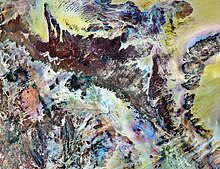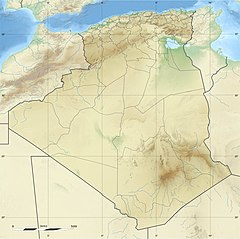Tassili Plateau

Landsat multilayer image of the Tassili n'Ajjer
|
|
| UNESCO World Heritage Site | |
|---|---|
| Location | Algeria |
| Coordinates | 25°40′00″N 9°00′00″E / 25.6667°N 9°E |
| Includes | Tassili n'Ajjer Cultural Park |
| Criteria | Cultural and Natural: (i), (iii), (vii), (viii) |
| Reference | 179 |
| Inscription | 1982 (6th Session) |
|
[]
|
|
| Tassili n'Ajjer National Park | |
|---|---|
|
IUCN category II (national park)
|
|
| Location | Tamanrasset Province, Algeria |
| Coordinates | 25°45′N 8°15′E / 25.750°N 8.250°E |
| Area | 72,000 km2 (28,000 sq mi) |
| Established | 1972 |
Tassili n'Ajjer (Berber: Tasili n Ajjer, Arabic: طاسيلي ناجر, English: Plateau of the Rivers) is a heavily eroded sandstone rock formation in the Algerian section of the Sahara Desert, situated on a vast plateau, that encompasses south-east Algeria, western Libya and northern Niger. It features over 300 rock arches, dense clusters of eroded sandstone rock pillars and steep cliffs and gorges where water pools permanently at the surface. Tassili n'Ajjer covers an area of over 72,000 km2 (28,000 sq mi).
The rock formation is an archaeological site, noted for its numerous prehistoric parietal works of rock art, first reported in 1910, that date to the early Neolithic era at the end of the last glacial period during which the Sahara was an inhabitable savanna rather than the current desert. Although sources vary considerably, the earliest pieces of art are assumed to be 12,000 years old. the vast majority date to the 9th and 10th millennia BP or younger, according to OSL dating of associated sediments. Among the 15,000 engravings so far identified depicted are large wild animals including antelopes and crocodiles, cattle herds and humans that engage in activities such as hunting and dancing. According to UNESCO, "The exceptional density of paintings and engravings...have made Tassili world famous."
...
Wikipedia

